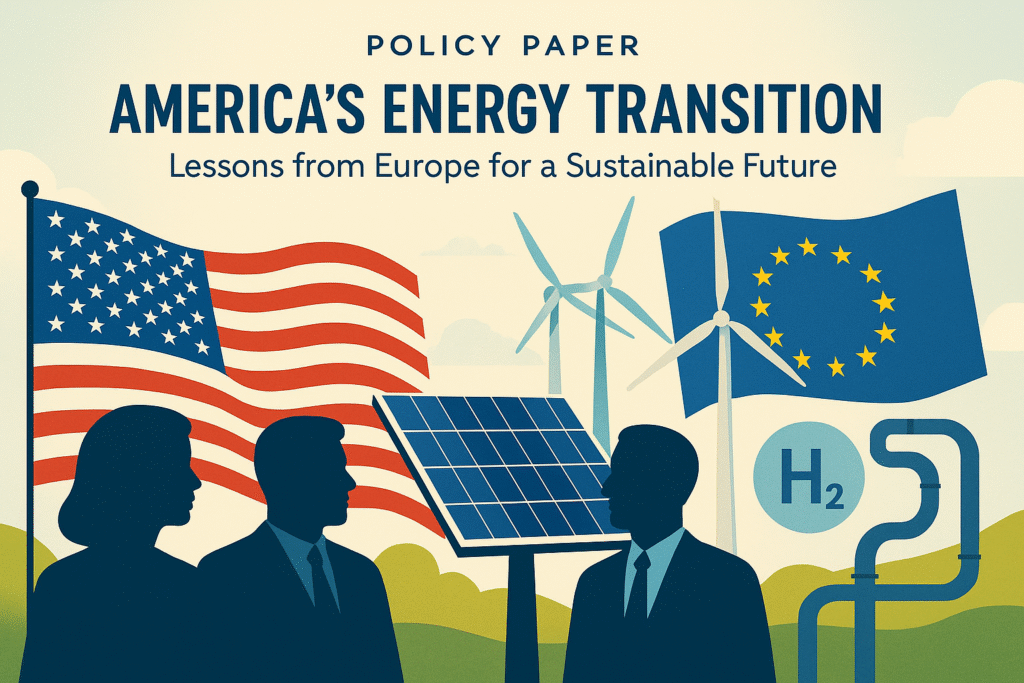Policy Paper
America’s Energy Transition: Lessons from Europe for a Sustainable Future
Executive Summary
The United States is at a pivotal moment in its energy transition. Facing climate change, global competitiveness challenges, and a shifting geopolitical landscape, the U.S. must transform its energy system while ensuring economic stability, equity, and security. Europe’s experience with the European Green Deal, REPowerEU, and Just Transition mechanisms provides important lessons. This paper outlines how the U.S. can adapt these strategies to its federal system, economic diversity, and polarized political environment.
Table of Contents
-
Introduction: Why America’s Energy Transition Matters
-
Defining the U.S. Energy Transition in 2025
-
Drivers of America’s Transformation
-
Lessons from Europe for the U.S.
-
Case Studies of U.S. Energy Transition in Action
-
Traits of Transformational U.S. Energy Leaders
-
Enablers: Institutional, Economic, and Social Foundations
-
Barriers and Risks Facing the U.S.
-
Policy Recommendations for America
-
Conclusion
1. Introduction: Why America’s Energy Transition Matters
The U.S. is the second-largest emitter of CO₂ and a global energy leader. Its energy transition will not only determine its domestic sustainability but also its geopolitical and economic standing. Yet, while the U.S. has launched historic climate legislation—most notably the Inflation Reduction Act (IRA)—progress is uneven.
Europe’s example provides valuable insights into:
-
Setting binding targets with credibility.
-
Designing just transition mechanisms for vulnerable workers and communities.
-
Investing in cross-border and cross-sector infrastructure.
2. Defining the U.S. Energy Transition in 2025
America’s energy transition involves:
-
Expanding renewables (solar, wind, hydropower).
-
Investing in clean hydrogen, carbon capture, and nuclear innovation.
-
Building resilient grids to handle electrification and renewables variability.
-
Creating green jobs while protecting fossil fuel-dependent communities.
-
Embedding justice and equity in transition policies (via programs like Justice40).
3. Drivers of America’s Transformation
-
Climate commitments: The U.S. has pledged to cut GHG emissions by 50–52% by 2030 (whitehouse.gov).
-
Economic competitiveness: Renewable and EV industries are key to competing with China and Europe.
-
Energy security: Reducing reliance on volatile global fossil markets.
-
Equity imperatives: Addressing disparities in energy costs and access.
-
Public health: Reducing pollution-driven illnesses and health inequities.
4. Lessons from Europe for the U.S.
-
Ambition with Binding Frameworks
Europe sets legally binding targets, while U.S. policies remain vulnerable to political swings. -
Just Transition Mechanisms
The EU funds retraining and support for coal regions; the U.S. must expand such mechanisms beyond ad hoc programs. -
Cross-Border and Sector Coupling
Europe’s integration of grids and hydrogen pipelines shows the need for U.S. interstate grid modernization and sector integration. -
Citizen Engagement and Social Legitimacy
Europe emphasizes citizen consultation; the U.S. must prioritize public buy-in to avoid backlash against infrastructure projects.
5. Case Studies of U.S. Energy Transition in Action
-
Inflation Reduction Act (2022): $369 billion in climate and clean energy investments—the most ambitious U.S. legislation to date.
-
California’s Climate Action Plan: Aggressive renewable targets and EV mandates serving as a state-level model.
-
Texas Wind Power Leadership: Texas leads in wind power capacity, showing how markets can drive rapid renewable growth.
-
Appalachia’s Transition Programs: Retraining coal workers for renewable and advanced manufacturing jobs.
6. Traits of Transformational U.S. Energy Leaders
-
Pragmatic visionaries: Bold yet realistic, linking climate goals to economic benefits.
-
Bridge-builders: Capable of bipartisan cooperation in a polarized system.
-
Equity advocates: Prioritizing vulnerable and historically marginalized communities.
-
Tech-savvy: Understanding emerging energy technologies.
-
Resilient under crises: From climate disasters to geopolitical shocks.
7. Enablers: Institutional, Economic, and Social Foundations
-
Federal funding via the IRA and Infrastructure Investment and Jobs Act (IIJA).
-
Strong R&D institutions (DOE labs, universities).
-
Private sector innovation in renewables and EVs.
-
State leadership (California, New York, Texas).
-
Civil society and community advocacy for climate justice.
8. Barriers and Risks Facing the U.S.
-
Political polarization undermining policy continuity.
-
Fragmented grids and permitting delays.
-
Inequalities in access to clean energy and jobs.
-
Over-reliance on tax credits which may not benefit lower-income households equally.
-
Industrial pushback from fossil fuel sectors.
9. Policy Recommendations for America
-
Legislate binding national targets to provide certainty beyond election cycles.
-
Expand just transition funding to ensure coal, oil, and gas-dependent regions have pathways forward.
-
Modernize the national grid with federal-state cooperation.
-
Embed equity into all energy policies, ensuring rural, Indigenous, and low-income communities benefit.
-
Accelerate permitting reform while maintaining transparency and community consultation.
-
Foster cross-sector innovation ecosystems, linking energy, transportation, housing, and digital sectors.
-
Invest in workforce reskilling for the clean economy.
10. Conclusion
After fifty years of transformation analysis, I see America at a crossroads. The U.S. has the resources, innovation, and political tools to lead the global energy transition—but it must combine European lessons on ambition, equity, and integration with American strengths in innovation and markets.
If transformational leaders can bridge divides and embed justice in this transition, America can chart a sustainable future while setting a blueprint for global sustainability.
References
-
White House (2022). Inflation Reduction Act Overview. (whitehouse.gov)
-
Gallup (2024). Trust in Government Remains Near Historic Lows. (gallup.com)
-
European Commission (2023). REPowerEU Plan. (european-union.europa.eu)
-
Reuters (2025). German Industry Lobby on Energy Transition Costs. (reuters.com)
